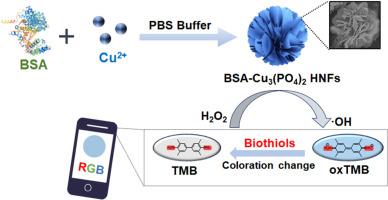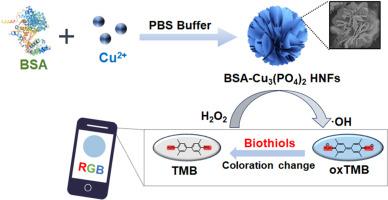Preparation of copper-based protein-inorganic hybrid nanoflowers with peroxidase-like activity for colorimetric detection of biothiols
IF 6
2区 化学
Q1 CHEMISTRY, ANALYTICAL
引用次数: 0
Abstract
Background
Biothiols play significant roles in maintaining cellular redox balance detoxification, signal transduction, and protein structure stabilization. Developing detection methods for biothiols analysis has gradually become an effective approach to monitor their contents fluctuation and evaluate these relative health problems in humans. Although conventional methods for biothiols analysis have been designed, it still remains the limitation of bulky-instrument requirements, inconvenience and inefficiency in practical measurement. Hence, there is an urgent demand to develop efficient detection methods for monitoring biothiols in real scenarios.
Results
By virtue of the highly stable and efficient peroxidase (POD)-like activity of nanozymes, we here propose a nanozyme-based visual detection method that rationally integrated the facile synthesized BSA-Cu3(PO4)2 HNFs with a smartphone detection platform for proceeding visual and portable detection performances. In detail, we primarily utilize the bovine serum albumin (BSA) containing abundant amine and amide groups as the organic ligand and Cu3(PO4)2 as the inorganic active component to successfully prepare BSA-Cu3(PO4)2 HNFs, and then biothiols can be served as the competitors for disturbing the colorimetric signals produced by BSA-Cu3(PO4)2 HNFs-triggered peroxidization in the TMB-H2O2 system. Taking advantages of the favorable catalytic activity of BSA-Cu3(PO4)2 HNFs, it enables a sensitive detection for biothiols including glutathione (GSH), cysteine (Cys), and homocysteine (Hcy). The proposed method has presented good detection performances of biothiols with linear relationships ranging from 10 to 200 μM, and the corresponding limits of detection (LODs) of GSH, Cys, and Hcy were calculated to be 5.4 μM, 3.5 μM, and 7.7 μM, respectively.
Significance
This proposed method has also achieved a convenient detection performance to realize biothiols analysis in real scenarios. The colorimetric signals of biothiols can be transformed into RGB values by a smartphone-based detection platform, indicating the great potential in facile, sensitive, and instrument-free analysis in monitoring biothiols contents variation.


具有过氧化物酶样活性的铜基蛋白质-无机杂交纳米花的制备及其在生物硫醇比色检测中的应用
生物硫醇在维持细胞氧化还原平衡、解毒、信号转导和蛋白质结构稳定方面发挥着重要作用。发展生物硫醇分析的检测方法已逐渐成为监测其含量波动和评价人类相关健康问题的有效途径。虽然传统的生物硫醇分析方法已经被设计出来,但在实际测量中仍然存在仪器体积大、不方便和效率低的限制。因此,迫切需要开发有效的检测方法来监测真实场景中的生物硫醇。结果利用纳米酶高度稳定高效的过氧化物酶(POD)样活性,我们提出了一种基于纳米酶的视觉检测方法,该方法将易于合成的BSA-Cu3(PO4)2 hnf与智能手机检测平台合理结合,实现了可视化和便携检测的性能。我们首先利用含有丰富胺和酰胺基团的牛血清白蛋白(BSA)作为有机配体,以Cu3(PO4)2为无机活性成分,成功制备了BSA-Cu3(PO4)2 HNFs,然后利用生物硫醇作为竞争者,干扰TMB-H2O2体系中BSA-Cu3(PO4)2 HNFs引发的过氧化反应所产生的比色信号。利用BSA-Cu3(PO4)2 HNFs良好的催化活性,可以灵敏地检测谷胱甘肽(GSH)、半胱氨酸(Cys)和同型半胱氨酸(Hcy)等生物硫醇。该方法在10 ~ 200 μM的线性范围内具有良好的检测性能,GSH、Cys和Hcy的检出限分别为5.4 μM、3.5 μM和7.7 μM。意义该方法也实现了方便的检测性能,实现了真实场景下的生物硫醇分析。基于智能手机的检测平台可以将生物硫醇的比色信号转换为RGB值,这表明在监测生物硫醇含量变化方面具有简便、灵敏和无仪器分析的巨大潜力。
本文章由计算机程序翻译,如有差异,请以英文原文为准。
求助全文
约1分钟内获得全文
求助全文
来源期刊

Analytica Chimica Acta
化学-分析化学
CiteScore
10.40
自引率
6.50%
发文量
1081
审稿时长
38 days
期刊介绍:
Analytica Chimica Acta has an open access mirror journal Analytica Chimica Acta: X, sharing the same aims and scope, editorial team, submission system and rigorous peer review.
Analytica Chimica Acta provides a forum for the rapid publication of original research, and critical, comprehensive reviews dealing with all aspects of fundamental and applied modern analytical chemistry. The journal welcomes the submission of research papers which report studies concerning the development of new and significant analytical methodologies. In determining the suitability of submitted articles for publication, particular scrutiny will be placed on the degree of novelty and impact of the research and the extent to which it adds to the existing body of knowledge in analytical chemistry.
 求助内容:
求助内容: 应助结果提醒方式:
应助结果提醒方式:


